Sustainability Evaluation Based on a Three-Dimensional Ecological Footprint Model: A Case Study in Hunan, China
Abstract
1. Introduction
2. Literature Review
3. Study Area
4. Methods and Materials
4.1. Methods
4.1.1. Three-Dimensional Ecological Footprint Model
4.1.2. Indicator System for Sustainability Based on Ecological Footprint
4.1.3. Ecological Efficiency
4.2. Materials
5. Results and Discussion
5.1. Temporal and Spatial Variations in the Ecological Footprints in Hunan
5.2. Evolution of Ecological Sustainability in Hunan
5.2.1. Temporal and Spatial Variations in Ecological Capacity in Hunan
5.2.2. Analysis of Ecological Footprint Depth and Ecological Footprint Size
5.2.3. Analysis of Ecological Footprint Diversity Index and Development Capacity Index
5.3. Analysis of the Ecological Efficiency in Hunan
6. Conclusions
- The total ecological footprint of Hunan fluctuant increased from 2005 to 2015, and the ecological footprint of forest land accounted for 57.1% of the total ecological footprint; arable land and construction land are also important contributors to the ecological footprint of Hunan. The proportion of carbon footprint is small and shows a slow downward trend. This is mainly due to the fact that the carbon dioxide emissions of Hunan are smaller than the national average, and Hunan is actively promoting the development of low-carbon industries. Additionally, the ecological carrying capacity of Hunan remained basically stable in 2005–2015. The per capita ecological footprint size and depth increased first then decreased, and the ecological footprint depth is always greater than 1. Based on the above analysis, Hunan has been in a state of ecological deficit, and natural capital flow is not sufficient to meet consumption demand. In other words, ecological capital stock needs to be consumed to maintain development.
- The ecological footprint diversity index of most prefecture-level cities in Hunan shows an upward trend and is greater than 1, indicating that the coordination between economic development and ecological environment in Hunan has gradually improved, and the ecosystem is stable. Because the composition of ecological footprint in Huaihua and Xiangxi is unbalanced and the proportion of forest land and hydropower is too high, so the ecological footprint diversity index is lower than 1. The result of ecological economy development capacity shows that the level of ecological economy development ability of prefecture-level cities is low but present an improvement tendency.
- From the perspective of spatial distribution, the per capita ecological footprint of Hunan shows a pattern of “high in surround, low in the central”. The high value areas are mainly distributed in western Hunan and northern Hunan, and the low value areas are mainly distributed in central Hunan such as Xiangtan and Loudi. The distribution patterns of per capita ecological carrying capacity and per capita ecological footprint are similar, which is related to the stable distribution of arable land in Hunan.
- The ecological efficiency of Hunan increases with an average rate of 13.12% annually, but there are obvious differences among prefecture-level cities. The regions with high ecological efficiency are mainly Changsha-Zhuzhou-Xiangtan urban agglomeration and its surrounding areas, and the regions with low ecological efficiency are mainly distributed in western Hunan. It is found that the main reason for the improvement of ecological efficiency of Hunan is the improvement of the factor substitution rate, that is, the ecological capital is replaced by the capital stock and labor input.
Author Contributions
Funding
Conflicts of Interest
Nomenclature
| Acronyms | |
| EF | ecological footprint |
| EPI | ecological pressure index |
| CEPI | consumption footprint pressure index |
| PFPI | production footprint pressure index |
| EFCI | ecological footprint contribution index |
| NPP | net primary productivity |
| BTH | the Beijing–Tianjin–Hebei |
| ETI | ecological tension index |
| EOI | ecological occupancy index |
| EECI | ecological economic coordination index |
| CHANS | coupled human and natural systems |
| EV | ecosystem vigor |
| RECC | resources and environmental carrying capacity |
| SDA | social development ability |
| ELF | ecological loss footprint |
| ESF | ecological supply footprint |
| SHP | small hydropower |
| BC | biological capacity |
| MGI | Maastricht globalization index |
| WCED | the world commission on environment and development |
| ES | ecological surplus |
| ED | ecological deficit |
| EFdepth | ecological footprint depth |
| EFsize | ecological footprint size |
| EE | ecological efficiency |
| EFFCH | technical efficiency change |
| TECH | technical progress |
| INPSUB | substitution effect of input factors |
| TFPCH | the change of total factor productivity |
| DEA | data envelopment analysis |
| NHA | national hectare |
Appendix A
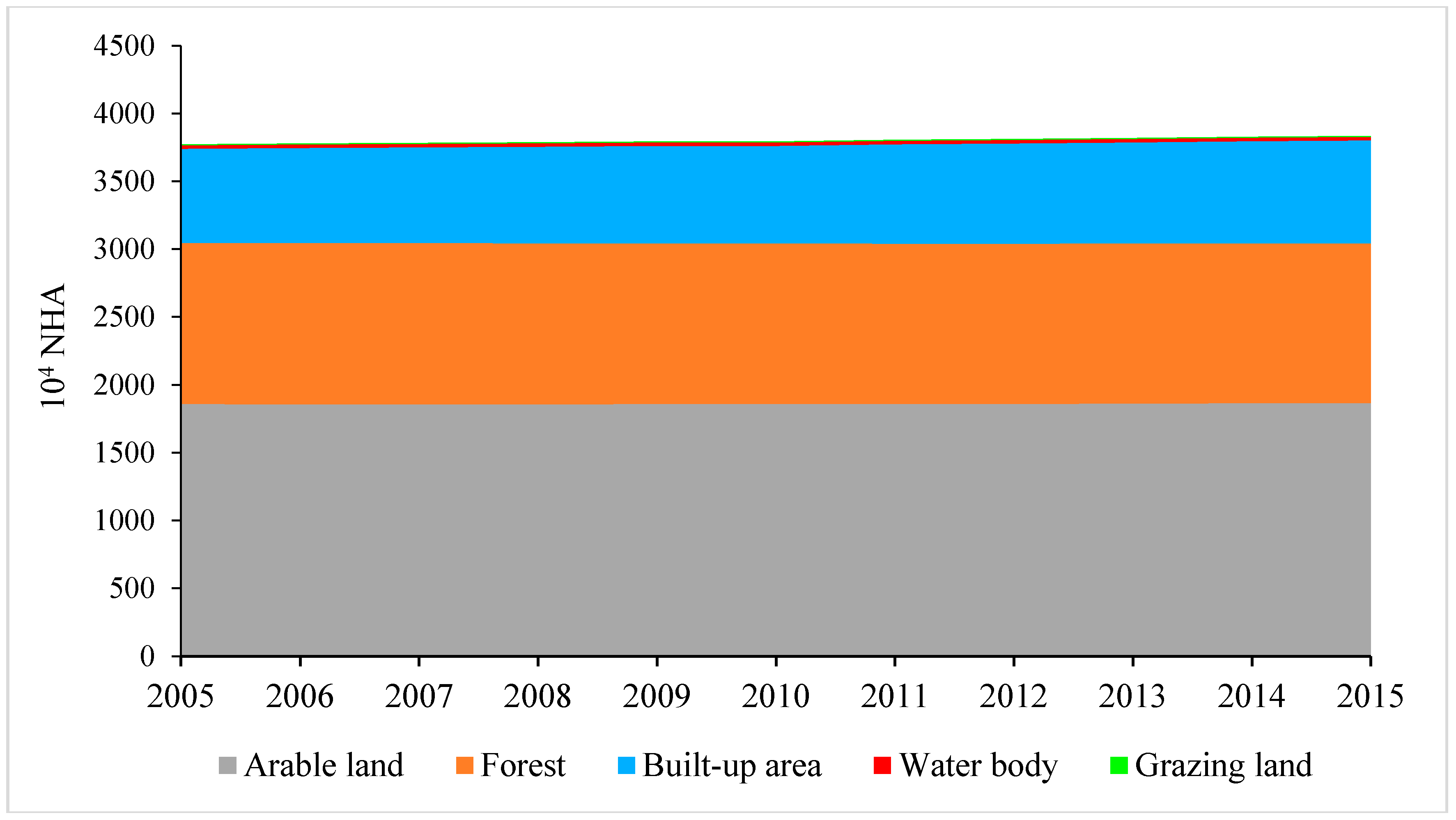
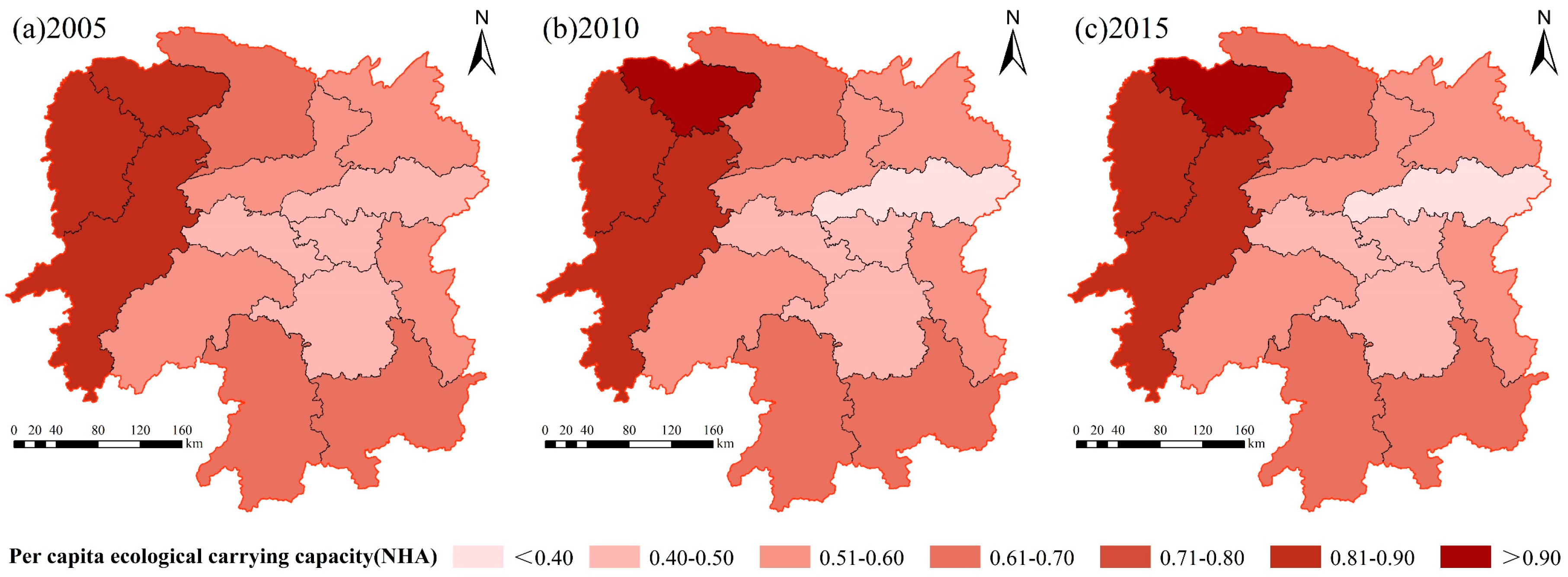
References
- Wackemagel, M.; Rees, W.E. Perceptual and structural barriers to investing in natural capital: Economics from an ecological footprint perspective. Ecol. Econ. 1997, 20, 3–24. [Google Scholar] [CrossRef]
- Fu, W.; Turner, J.C.; Zhao, J.; Du, G. Ecological footprint (EF): An expanded role in calculating resource productivity (RP) using China and the G20 member countries as examples. Ecol. Indic. 2015, 48, 464–471. [Google Scholar] [CrossRef]
- Yue, S.; Yang, Y.; Shao, J.; Zhu, Y. International Comparison of Total Factor Ecology Efficiency: Focused on G20 from 1999–2013. Sustainability 2016, 8, 1129. [Google Scholar] [CrossRef]
- Ozturk, I.; Al-Mulali, U.; Saboori, B. Investigating the environmental Kuznets curve hypothesis: The role of tourism and ecological footprint. Environ. Sci. Pollut. Res. Int. 2016, 23, 1916–1928. [Google Scholar] [CrossRef] [PubMed]
- Siche, R.; Pereira, L.; Agostinho, F.; Ortega, E. Convergence of ecological footprint and emergy analysis as a sustainability indicator of countries: Peru as case study. Commun. Nonlinear Sci. Numer. Simul. 2010, 15, 3182–3192. [Google Scholar] [CrossRef]
- Wu, D.; Liu, J. Multi-Regional Input-Output (MRIO) Study of the Provincial Ecological Footprints and Domestic Embodied Footprints Traded among China’s 30 Provinces. Sustainability 2016, 8, 1345. [Google Scholar] [CrossRef]
- He, Y.; Che, T.; Wang, Y. Ecological Footprint and Endogenous Economic Growth in the Poyang Lake Area in China Based on Empirical Analysis of Panel Data Model. J. Resour. Ecol. 2012, 3, 367–372. [Google Scholar]
- Wang, S.; Yang, F.-L.; Xu, L.; Du, J. Multi-scale analysis of the water resources carrying capacity of the Liaohe Basin based on ecological footprints. J. Clean. Prod. 2013, 53, 158–166. [Google Scholar] [CrossRef]
- Li, X.; Tian, M.; Wang, H.; Wang, H.; Yu, J. Development of an ecological security evaluation method based on the ecological footprint and application to a typical steppe region in China. Ecol. Indic. 2014, 39, 153–159. [Google Scholar] [CrossRef]
- Gu, Q.; Wang, H.; Zheng, Y.; Zhu, J.; Li, X. Ecological footprint analysis for urban agglomeration sustainability in the middle stream of the Yangtze River. Ecol. Model. 2015, 318, 86–99. [Google Scholar] [CrossRef]
- Li, J.; Liu, Z.; He, C.; Tu, W.; Sun, Z. Are the drylands in northern China sustainable? A perspective from ecological footprint dynamics from 1990 to 2010. Sci. Total Environ. 2016, 553, 223–231. [Google Scholar] [CrossRef] [PubMed]
- Yin, Y.; Han, X.; Wu, S. Spatial and Temporal Variations in the Ecological Footprints in Northwest China from 2005 to 2014. Sustainability 2017, 9, 597. [Google Scholar] [CrossRef]
- Xie, Z.; Gao, Y.; Li, C.; Zhou, J.; Zhang, T. Spatial Heterogeneity of Typical Ecosystem Services and Their Relationships in Different Ecological–Functional Zones in Beijing–Tianjin–Hebei Region, China. Sustainability 2017, 10, 6. [Google Scholar] [CrossRef]
- Chu, X.; Deng, X.; Jin, G.; Wang, Z.; Li, Z. Ecological security assessment based on ecological footprint approach in Beijing-Tianjin-Hebei region, China. Phys. Chem. Earthparts A/B/C 2017, 101, 43–51. [Google Scholar] [CrossRef]
- Wang, M.; Liu, J.; Wang, J.; Zhao, G. Ecological footprint and major driving forces in West Jilin Province, Northeast China. Chin. Geogr. Sci. 2010, 20, 434–441. [Google Scholar] [CrossRef]
- He, J.; Wan, Y.; Feng, L.; Ai, J.; Wang, Y. An integrated data envelopment analysis and emergy-based ecological footprint methodology in evaluating sustainable development, a case study of Jiangsu Province, China. Ecol. Indic. 2016, 70, 23–34. [Google Scholar] [CrossRef]
- Miao, C.-L.; Sun, L.-Y.; Yang, L. The studies of ecological environmental quality assessment in Anhui Province based on ecological footprint. Ecol. Indic. 2016, 60, 879–883. [Google Scholar] [CrossRef]
- Wang, Y.; Li, X.; Li, J. Study on the response of ecological capacity to land-use/cover change in Wuhan city: A remote sensing and GIS based approach. Sci. World J. 2014, 2014, 794323. [Google Scholar] [CrossRef] [PubMed]
- Yao, X.; Wang, Z.; Zhang, H. Dynamic Changes of the Ecological Footprint and Its Component Analysis Response to Land Use in Wuhan, China. Sustainability 2016, 8, 329. [Google Scholar] [CrossRef]
- Wang, F.; Wang, K. Assessing the Effect of Eco-City Practices on Urban Sustainability Using an Extended Ecological Footprint Model: A Case Study in Xi’an, China. Sustainability 2017, 9, 1591. [Google Scholar] [CrossRef]
- Li, Y.; Zhan, J.; Zhang, F.; Zhang, M.; Chen, D. The study on ecological sustainable development in Chengdu. Phys. Chem. Earthparts A/B/C 2017, 101, 112–120. [Google Scholar] [CrossRef]
- Fan, Y.; Qiao, Q.; Xian, C.; Xiao, Y.; Fang, L. A modified ecological footprint method to evaluate environmental impacts of industrial parks. Resour. Conserv. Recycl. 2017, 125, 293–299. [Google Scholar] [CrossRef]
- Zhen, L.; Du, B. Ecological Footprint Analysis Based on Changing Food Consumption in a Poorly Developed Area of China. Sustainability 2017, 9, 1323. [Google Scholar] [CrossRef]
- Dai, L.; Xu, B.; Wu, B. Assessing sustainable development of a historic district using an ecological footprint model: A case study of Nanluoguxiang in Beijing, China. Area 2017, 49, 94–105. [Google Scholar] [CrossRef]
- Chen, J.; Ye, G.; Jing, C.; Wu, J.; Ma, P. Ecological footprint analysis on tourism carrying capacity at the Zhoushan Archipelago, China. Asia Pac. J. Tour. Res. 2017, 22, 1049–1062. [Google Scholar] [CrossRef]
- Chen, H.S. Evaluation and Analysis of Eco-Security in Environmentally Sensitive Areas Using an Emergy Ecological Footprint. Int J Env. Res Public Health 2017, 14, 136. [Google Scholar] [CrossRef] [PubMed]
- Tian, M. Study on Sustainable Development of Agriculture in Dabieshan Pilot Site Based on the Model of Ecological Footprint. Int. J. Environ. Prot. Policy 2015, 3, 124–128. [Google Scholar] [CrossRef]
- Peng, J.; Du, Y.; Liu, Y.; Hu, X. How to assess urban development potential in mountain areas? An approach of ecological carrying capacity in the view of coupled human and natural systems. Ecol. Indic. 2016, 60, 1017–1030. [Google Scholar] [CrossRef]
- Wang, Y.; Wang, L.; Shao, H. Ecological Footprint Analysis Applied to a Coal-Consumption County in China. Clean Soil Air Water 2014, 42, 1004–1013. [Google Scholar] [CrossRef]
- Bai, X.; Wen, Z.; An, S.; Li, B. Evaluating sustainability of cropland use in Yuanzhou county of the Loess plateau, China using an emergy-based ecological footprint. PLoS ONE 2015, 10, e0118282. [Google Scholar] [CrossRef] [PubMed]
- Wang, J.; Zhang, Q.; Zou, C. Dynamic evolutions of ecological carrying capacity in poor areas using ecological footprint model at Ruyang County of China. Int. J. Agric. Biol. Eng. 2017, 10, 140–150. [Google Scholar]
- Dang, X.; Liu, G.; Xue, S.; Li, P. An ecological footprint and emergy based assessment of an ecological restoration program in the Loess Hilly Region of China. Ecol. Eng. 2013, 61, 258–267. [Google Scholar] [CrossRef]
- Wei, X.Y.; Xia, J.X. Ecological compensation for large water projects based on ecological footprint theory: A case study in China. Procedia Environ. Sci. 2012, 13, 1338–1345. [Google Scholar] [CrossRef]
- Wang, C.; Shi, G.; Wei, Y.; Western, A.; Zheng, H.; Zhao, Y. Balancing Rural Household Livelihood and Regional Ecological Footprint in Water Source Areas of the South-to-North Water Diversion Project. Sustainability 2017, 9, 1393. [Google Scholar] [CrossRef]
- Wang, Z.; Li, Q.; Huang, Z.; Tang, X.; Zhao, W. Ecological footprint analysis of environmental impacts by cascaded exploitation of diversion-type small hydropower: A case study in southwest china. Iop Conf. Ser. Earth Environ. Sci. 2017, 64, 012056. [Google Scholar] [CrossRef]
- Hu, J.; Zhen, L.; Sun, C.-Z.; Du, B.-Z.; Wang, C. Ecological Footprint of Biological Resource Consumption in a Typical Area of the Green for Grain Project in Northwestern China. Environments 2015, 2, 44–60. [Google Scholar] [CrossRef]
- Wu, X.F.; Yang, Q.; Xia, X.H.; Wu, T.H.; Wu, X.D.; Shao, L.; Hayat, T.; Alsaedi, A.; Chen, G.Q. Sustainability of a typical biogas system in China: Emergy-based ecological footprint assessment. Ecol. Inform. 2015, 26, 78–84. [Google Scholar] [CrossRef]
- Liu, X.; Jiang, D.; Wang, Q.; Liu, H.; Li, J.; Fu, Z. Evaluating the Sustainability of Nature Reserves Using an Ecological Footprint Method: A Case Study in China. Sustainability 2016, 8, 1272. [Google Scholar] [CrossRef]
- Chen, D.-D.; Gao, W.-S.; Chen, Y.-Q.; Zhang, Q. Ecological footprint analysis of food consumption of rural residents in China in the latest 30 years. Agric. Agric. Sci. Procedia 2010, 1, 106–115. [Google Scholar] [CrossRef]
- Song, G.; Li, M.; Semakula, H.M.; Zhang, S. Food consumption and waste and the embedded carbon, water and ecological footprints of households in China. Sci. Total Environ. 2015, 529, 191–197. [Google Scholar] [CrossRef] [PubMed]
- Lazarus, E.; Lin, D.; Martindill, J.; Hardiman, J.; Pitney, L.; Galli, A. Biodiversity Loss and the Ecological Footprint of Trade. Diversity 2015, 7, 170–191. [Google Scholar] [CrossRef]
- Figge, L.; Oebels, K.; Offermans, A. The effects of globalization on Ecological Footprints: An empirical analysis. Environ. Dev. Sustain. 2016, 19, 863–876. [Google Scholar] [CrossRef]
- Gao, J.; Tian, M. Analysis of over-consumption of natural resources and the ecological trade deficit in China based on ecological footprints. Ecol. Indic. 2016, 61, 899–904. [Google Scholar] [CrossRef]
- Niccolucci, V.; Galli, A.; Reed, A.; Neri, E.; Wackernagel, M.; Bastianoni, S. Towards a 3D National Ecological Footprint Geography. Ecol. Model. 2011, 222, 2939–2944. [Google Scholar] [CrossRef]
- Fang, K. Ecological footprint depth and size: New indicators for a 3D model. Acta Ecol. Sin. 2013, 33, 267–274. [Google Scholar] [CrossRef]
- Peng, J.; Du, Y.; Ma, J.; Liu, Z.; Liu, Y.; Wei, H. Sustainability evaluation of natural capital utilization based on 3DEF model: A case study in Beijing City, China. Ecol. Indic. 2015, 58, 254–266. [Google Scholar] [CrossRef]
- National Economic and Social Development Bulletin of Hunan Province in 2015. (In Chinese). Available online: http://www.ha.stats.gov.cn/sitesources/hntj/page_pc/tjfw/tjgb/gjhgsgb/article656d9778f3764987a8f6413edb093bb2.html (accessed on 26 November 2018).
- Geographical Situation. Hunan Provincial People’s Government. (In Chinese). Available online: http://www.hunan.gov.cn (accessed on 26 November 2018).
- Wackernagel, M.; Onisto, L.; Bello, P.; Linares, A.C.; Falfan, I.S.L.; GarcıA, J.M.; Guerrero, A.I.S.; Ma, G.S.G. National natural capital accounting with the ecological footprint concept. Ecol. Econ. 1999, 29, 375–390. [Google Scholar] [CrossRef]
- Yang, Y.; Hu, D. Natural capital utilization based on a three-dimensional ecological footprint model: A case study in northern Shaanxi, China. Ecol. Indic. 2018, 87, 178–188. [Google Scholar] [CrossRef]
- Ulanowicz, R.E. Growth and Development: Ecosystems Phenomenology; Springer: New York, NY, USA, 1986. [Google Scholar]
- Färe, R.; Grosskopf, S.; Norris, M.; Zhang, Z. Productivity Growth, Technical Progress, and Efficiency Change in Industrialized Countries. Am. Econ. Rev. 1994, 84, 66–83. [Google Scholar]
- Li, K.; Lin, B. How to promote energy efficiency through technological progress in China? Energy 2018, 143, 812–821. [Google Scholar] [CrossRef]
- Wackernagel, M.; White, S.; Moran, D. Using ecological footprint accounts: From analysis to applications. Int. J. Environ. Sustain. Dev. 2004, 3, 293–315. [Google Scholar] [CrossRef]
- Xun, F.; Hu, Y. Evaluation of ecological sustainability based on a revised three-dimensional ecological footprint model in Shandong Province, China. Sci. Total Environ. 2019, 649, 582–591. [Google Scholar] [CrossRef] [PubMed]
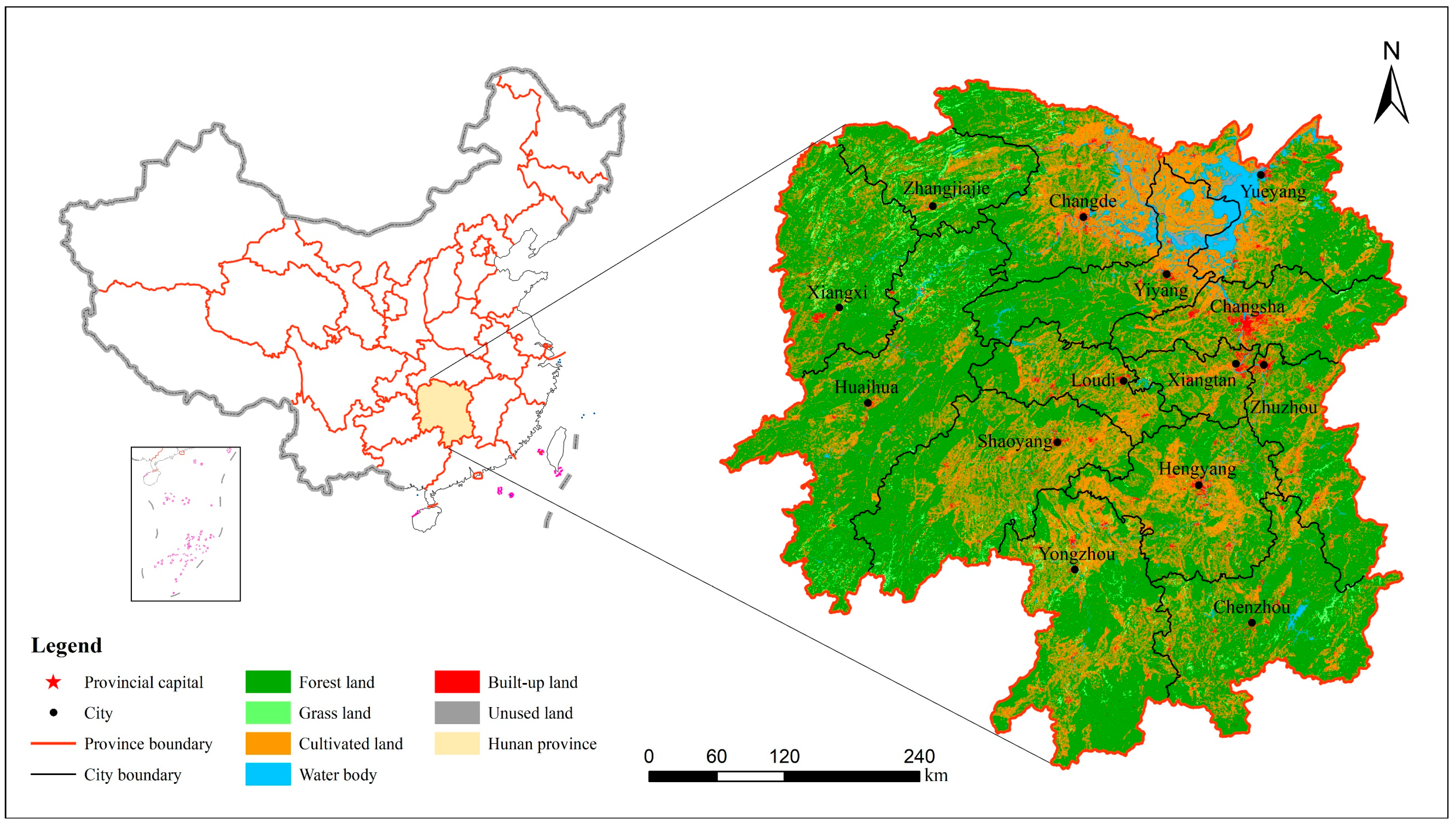
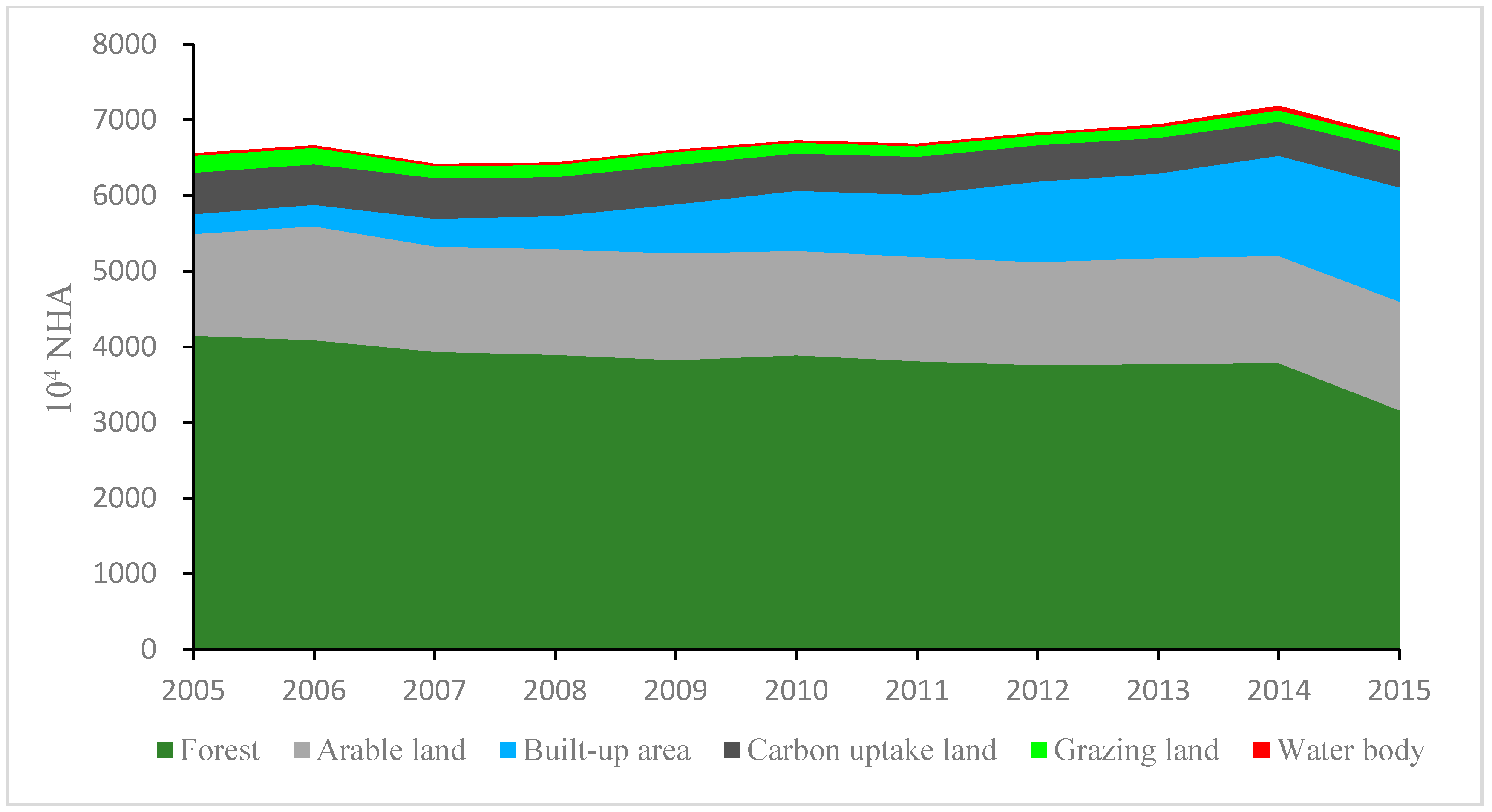
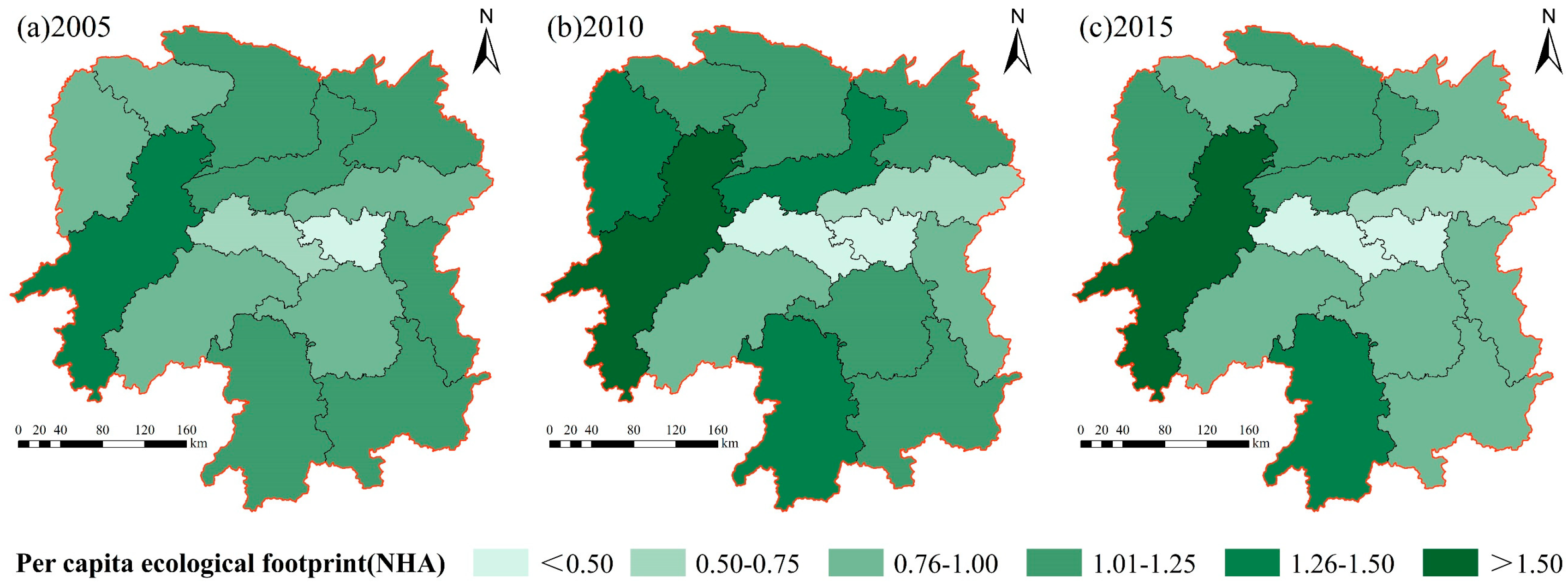

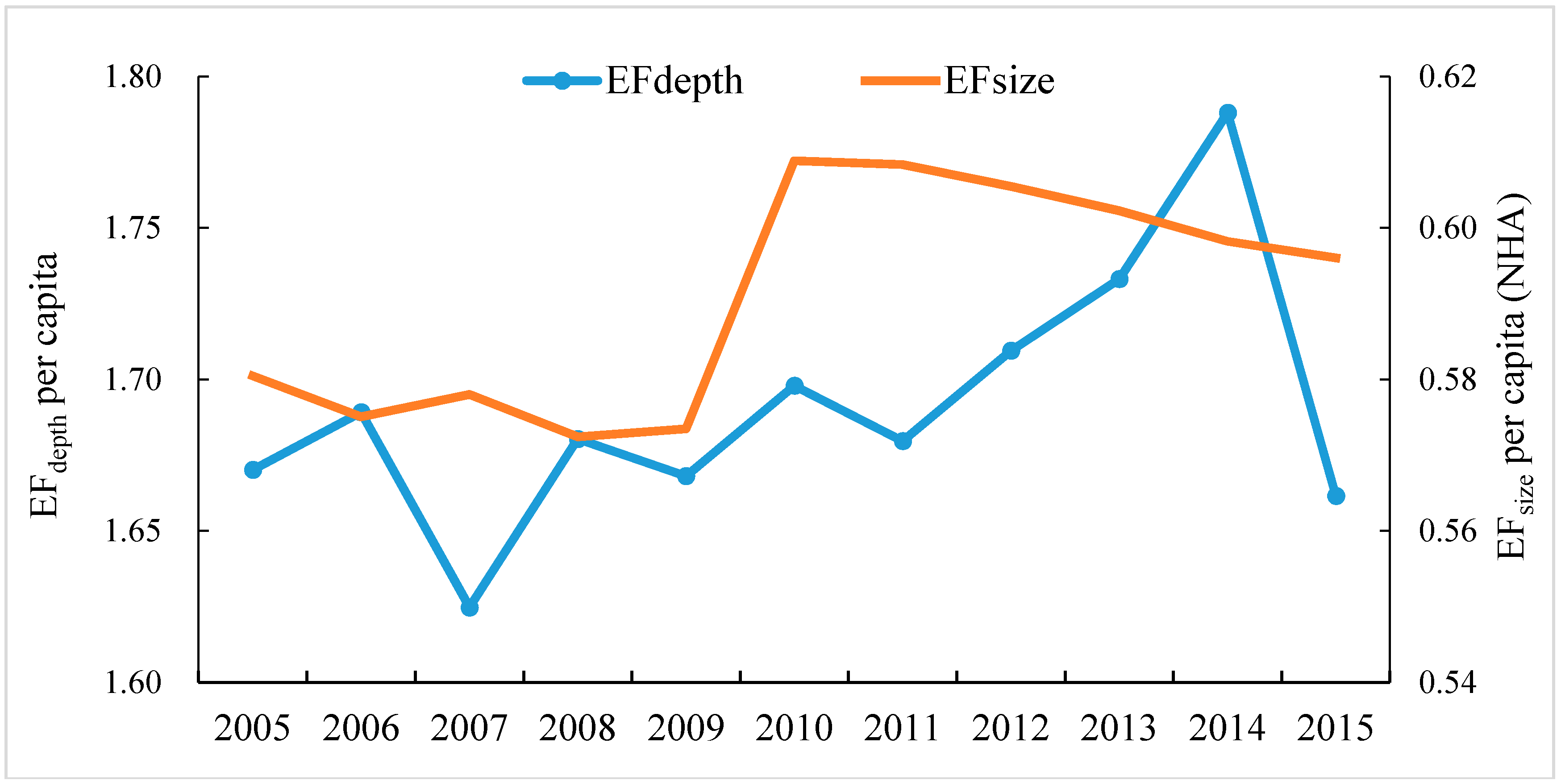
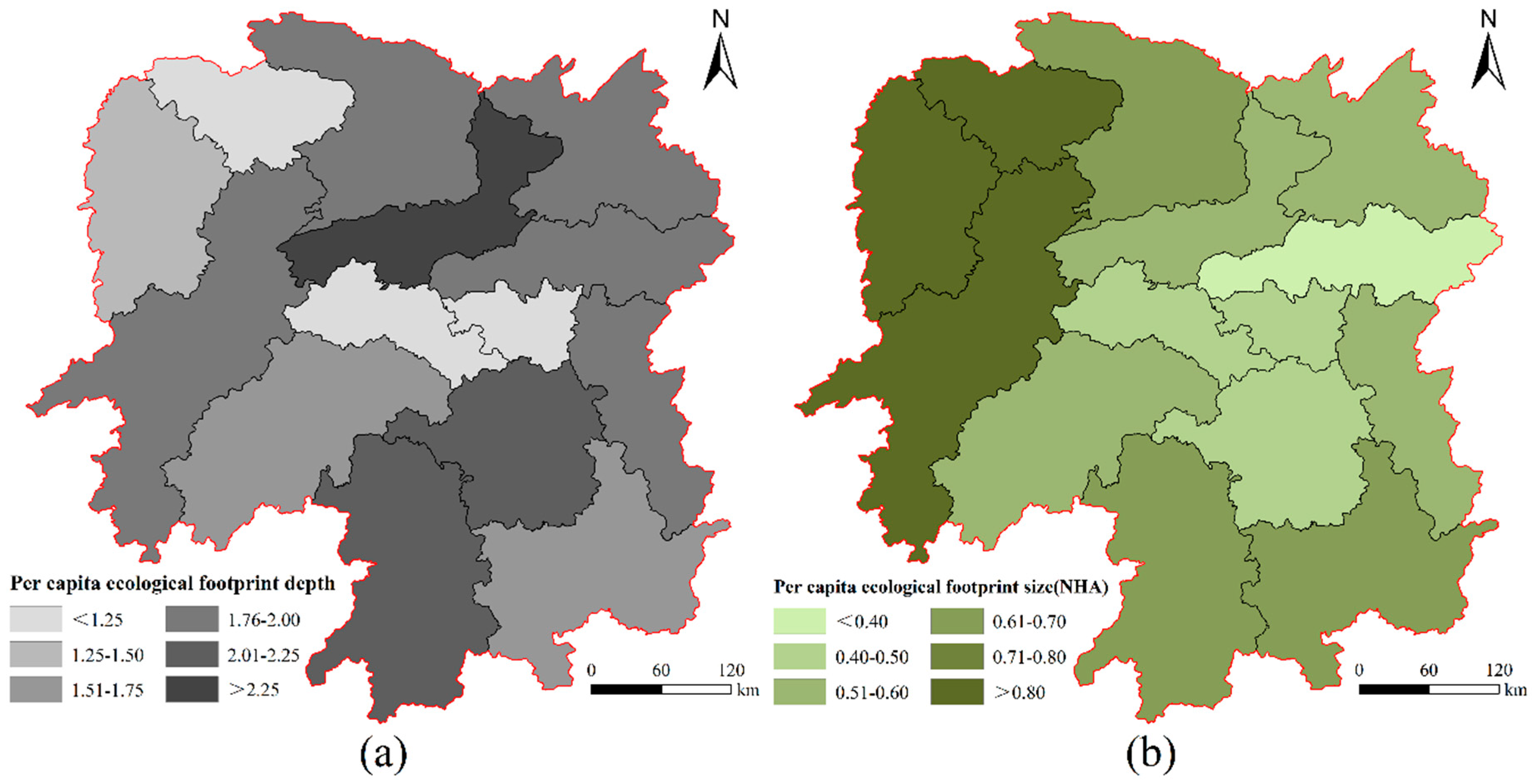
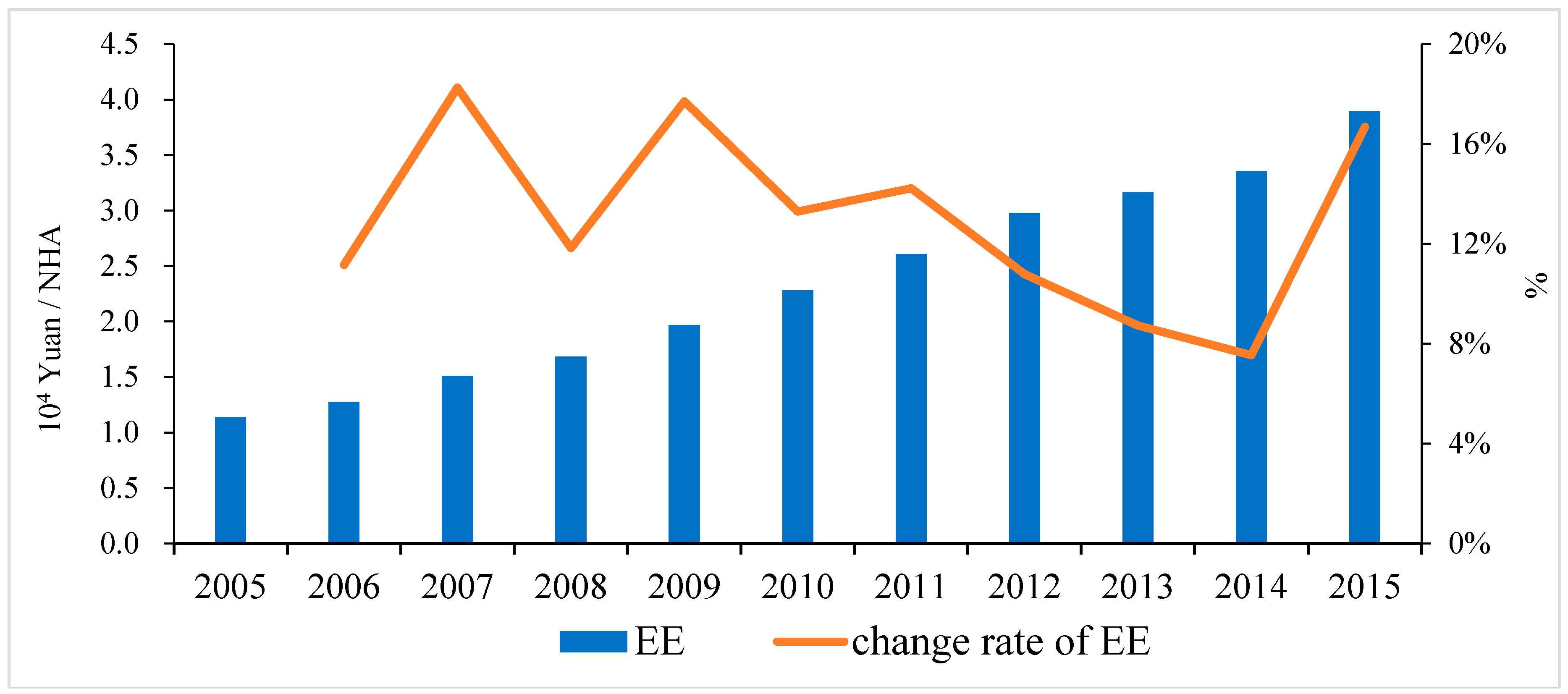
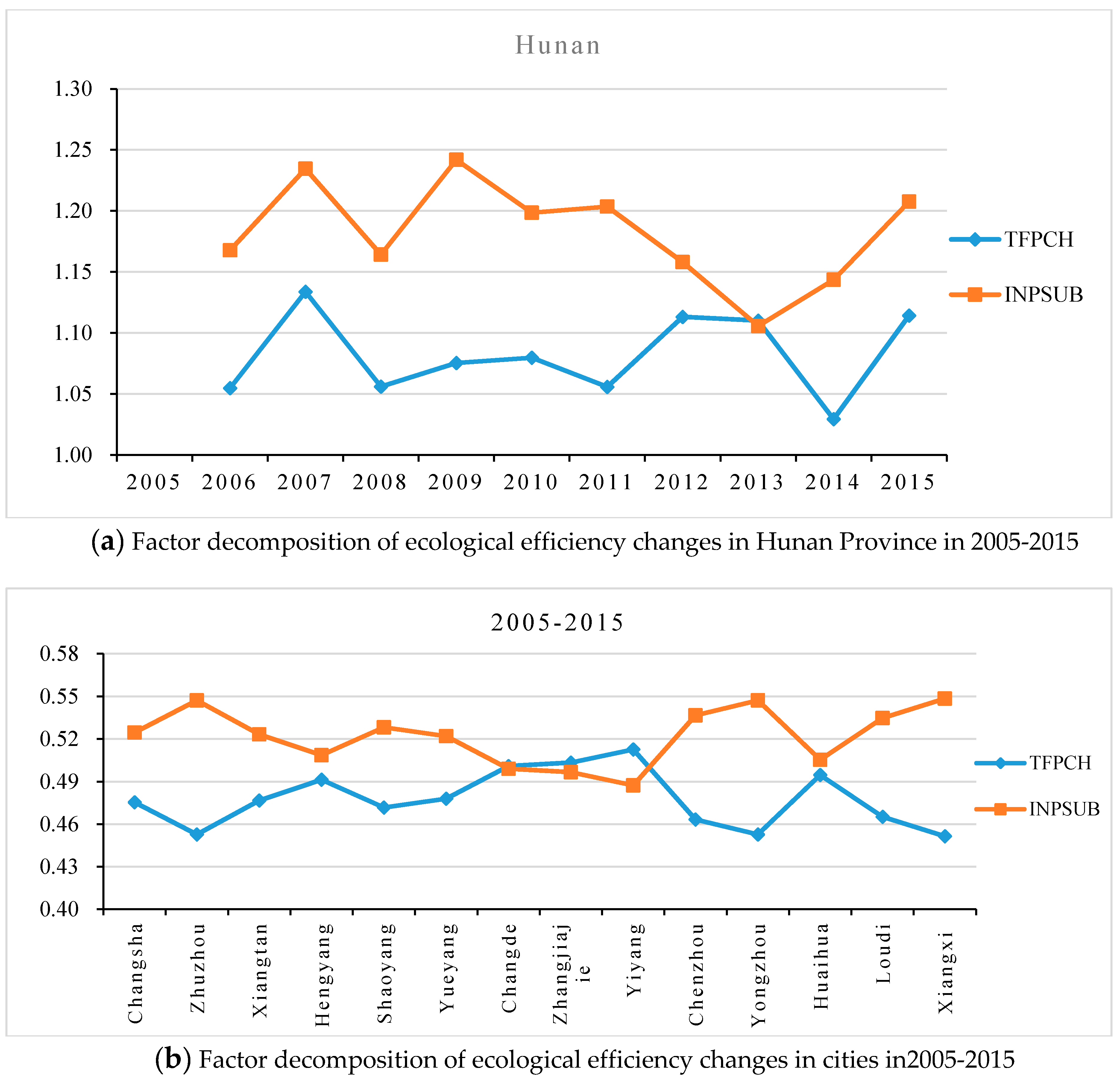
| Land Categories | Items of Biological Products and Energy Sources in Hunan |
|---|---|
| Arable land | Grains, rice, wheat, corn, other food crops; beans, potatoes, peanuts, rapeseed, sesame, other oils, cotton, hemp, tobacco, medicinal herbs, vegetables, fruit melons, pork, poultry meat, eggs |
| Grazing land | Beef and mutton, other meat, wool, milk, rabbit |
| Forest | Citrus, peach, pear, other fruits, tea, mulberry, lacquer, oil seed, camellia seed, turpentine, dried bamboo shoot, chestnut, wood, bamboo wood |
| Water bodies | Fish, crabs, shellfish and other aquatic products |
| Carbon uptake land (Carbon footprint) | Consumption of raw coal, coke, crude oil, gasoline, kerosene, diesel oil, fuel oil, liquefied petroleum gas, electricity |
| Built-up area | Hydroelectricity |
| Year | Ecological Footprint Diversity Index | |||||||||||||
|---|---|---|---|---|---|---|---|---|---|---|---|---|---|---|
| Changsha | Zhuzhou | Xiangtan | Hengyang | Shaoyang | Yueyang | Changde | Zhangjiajie | Yiyang | Chenzhou | Yongzhou | Huaihua | Loudi | Xiangxi | |
| 2005 | 1.23 | 0.97 | 1.17 | 1.09 | 1.02 | 1.02 | 1.09 | 1.07 | 1.02 | 1.07 | 0.95 | 0.90 | 1.13 | 0.76 |
| 2006 | 1.22 | 0.95 | 1.15 | 1.06 | 1.04 | 1.04 | 1.07 | 1.08 | 1.21 | 1.03 | 1.07 | 0.96 | 1.21 | 0.75 |
| 2007 | 1.18 | 1.03 | 1.15 | 1.06 | 1.07 | 1.03 | 1.10 | 1.05 | 1.18 | 1.05 | 0.96 | 0.98 | 1.24 | 0.74 |
| 2008 | 1.20 | 0.85 | 1.11 | 1.12 | 1.15 | 1.10 | 1.11 | 1.11 | 0.96 | 1.10 | 1.12 | 1.04 | 1.09 | 0.73 |
| 2009 | 1.21 | 1.36 | 1.15 | 1.14 | 1.18 | 1.05 | 1.16 | 1.15 | 0.94 | 1.13 | 1.18 | 1.02 | 1.33 | 0.76 |
| 2010 | 1.24 | 1.34 | 1.13 | 1.03 | 1.19 | 1.06 | 1.14 | 1.10 | 0.95 | 1.20 | 1.15 | 0.97 | 1.32 | 0.74 |
| 2011 | 1.25 | 1.25 | 1.16 | 1.04 | 1.16 | 1.14 | 1.10 | 1.06 | 1.01 | 1.26 | 1.14 | 1.01 | 1.31 | 0.71 |
| 2012 | 1.31 | 1.23 | 1.16 | 1.11 | 1.18 | 1.09 | 1.12 | 1.07 | 0.97 | 1.25 | 1.16 | 0.88 | 1.32 | 0.72 |
| 2013 | 1.28 | 1.29 | 1.16 | 1.15 | 1.24 | 1.12 | 1.08 | 1.12 | 0.94 | 1.27 | 1.16 | 0.84 | 1.35 | 0.77 |
| 2014 | 1.45 | 1.21 | 1.15 | 1.18 | 1.28 | 1.11 | 1.22 | 1.16 | 1.04 | 1.23 | 1.18 | 0.60 | 1.25 | 0.76 |
| 2015 | 1.37 | 1.39 | 1.21 | 1.16 | 1.38 | 0.67 | 1.34 | 1.20 | 1.26 | 1.32 | 1.25 | 0.50 | 1.40 | 0.89 |
| mean | 1.27 | 1.17 | 1.16 | 1.10 | 1.17 | 1.04 | 1.14 | 1.11 | 1.04 | 1.17 | 1.12 | 0.88 | 1.27 | 0.76 |
| Year | Development Capacity Index (NHA) | |||||||||||||
|---|---|---|---|---|---|---|---|---|---|---|---|---|---|---|
| Changsha | Zhuzhou | Xiangtan | Hengyang | Shaoyang | Yueyang | Changde | Zhangjiajie | Yiyang | Chenzhou | Yongzhou | Huaihua | Loudi | Xiangxi | |
| 2005 | 0.96 | 0.97 | 0.56 | 0.93 | 0.91 | 1.15 | 1.22 | 0.87 | 1.05 | 1.29 | 1.13 | 1.23 | 0.58 | 0.72 |
| 2006 | 0.95 | 1.00 | 0.51 | 0.93 | 0.93 | 1.17 | 1.24 | 0.83 | 1.01 | 1.27 | 1.29 | 1.42 | 0.69 | 0.79 |
| 2007 | 0.93 | 1.01 | 0.50 | 0.89 | 0.85 | 1.05 | 1.14 | 0.88 | 0.91 | 1.28 | 1.25 | 1.34 | 0.60 | 0.85 |
| 2008 | 0.92 | 1.29 | 0.44 | 0.85 | 0.86 | 0.99 | 1.17 | 0.90 | 1.07 | 1.11 | 1.17 | 1.36 | 0.70 | 0.84 |
| 2009 | 0.97 | 1.07 | 0.47 | 0.97 | 0.93 | 1.11 | 1.24 | 1.01 | 1.28 | 1.32 | 1.27 | 1.49 | 0.55 | 0.85 |
| 2010 | 0.88 | 1.09 | 0.47 | 1.06 | 0.95 | 1.08 | 1.29 | 1.17 | 1.39 | 1.36 | 1.59 | 1.60 | 0.58 | 0.95 |
| 2011 | 0.84 | 1.04 | 0.49 | 1.12 | 0.95 | 1.08 | 1.32 | 1.20 | 1.38 | 1.42 | 1.66 | 1.51 | 0.58 | 0.84 |
| 2012 | 0.78 | 1.08 | 0.48 | 1.00 | 0.96 | 0.93 | 1.36 | 1.16 | 1.60 | 1.57 | 1.72 | 1.52 | 0.61 | 0.83 |
| 2013 | 0.90 | 1.14 | 0.50 | 0.98 | 1.05 | 0.92 | 1.31 | 1.20 | 1.62 | 1.56 | 1.78 | 1.44 | 0.58 | 0.82 |
| 2014 | 1.10 | 1.27 | 0.47 | 0.95 | 1.17 | 0.94 | 1.45 | 1.07 | 1.77 | 1.27 | 1.84 | 1.23 | 0.70 | 0.79 |
| 2015 | 0.96 | 1.27 | 0.50 | 1.01 | 1.19 | 0.51 | 1.51 | 1.11 | 1.57 | 1.28 | 1.84 | 1.04 | 0.60 | 0.94 |
| mean | 0.93 | 1.11 | 0.49 | 0.97 | 0.98 | 0.99 | 1.30 | 1.04 | 1.33 | 1.34 | 1.50 | 1.38 | 0.61 | 0.84 |
| District | EE | Change Rate of EE (%) | ||||||
|---|---|---|---|---|---|---|---|---|
| 2005 | 2010 | 2015 | Mean | 2006 | 2010 | 2015 | Mean | |
| Changsha | 3.13 | 6.17 | 10.39 | 6.51 | 14.05 | 21.17 | 16.55 | 13.16 |
| Zhuzhou | 1.38 | 3.25 | 4.73 | 2.93 | 6.75 | 11.27 | 23.94 | 17.48 |
| Xiangtan | 2.65 | 6.27 | 10.70 | 6.35 | 20.64 | 20.90 | 8.58 | 15.12 |
| Hengyang | 0.96 | 1.53 | 2.97 | 1.84 | 9.48 | −1.56 | −0.20 | 12.47 |
| Shaoyang | 0.54 | 1.14 | 1.74 | 1.11 | 10.78 | 21.74 | 15.25 | 12.51 |
| Yueyang | 1.04 | 2.20 | 4.80 | 2.57 | 11.84 | 18.31 | 20.20 | 16.87 |
| Changde | 0.93 | 1.85 | 3.07 | 1.85 | 8.61 | 17.97 | 13.91 | 12.85 |
| Zhangjiajie | 0.85 | 1.33 | 2.41 | 1.47 | 18.72 | 4.93 | 7.31 | 11.24 |
| Yiyang | 0.62 | 0.88 | 1.70 | 0.99 | 36.19 | 16.55 | 48.28 | 12.44 |
| Chenzhou | 0.86 | 1.60 | 3.12 | 1.68 | 5.64 | 23.17 | 15.49 | 14.18 |
| Yongzhou | 0.53 | 0.95 | 1.40 | 0.94 | 10.25 | −0.24 | 14.96 | 10.78 |
| Huaihua | 0.44 | 0.70 | 0.86 | 0.70 | 2.44 | 9.79 | 5.03 | 7.58 |
| Loudi | 1.49 | 3.44 | 5.58 | 3.22 | 1.04 | 19.55 | 38.47 | 16.96 |
| Xiangxi | 0.48 | 0.63 | 1.10 | 0.72 | −0.28 | 2.56 | 5.75 | 8.64 |
© 2018 by the authors. Licensee MDPI, Basel, Switzerland. This article is an open access article distributed under the terms and conditions of the Creative Commons Attribution (CC BY) license (http://creativecommons.org/licenses/by/4.0/).
Share and Cite
Deng, C.; Liu, Z.; Li, R.; Li, K. Sustainability Evaluation Based on a Three-Dimensional Ecological Footprint Model: A Case Study in Hunan, China. Sustainability 2018, 10, 4498. https://doi.org/10.3390/su10124498
Deng C, Liu Z, Li R, Li K. Sustainability Evaluation Based on a Three-Dimensional Ecological Footprint Model: A Case Study in Hunan, China. Sustainability. 2018; 10(12):4498. https://doi.org/10.3390/su10124498
Chicago/Turabian StyleDeng, Chuxiong, Zhen Liu, Rongrong Li, and Ke Li. 2018. "Sustainability Evaluation Based on a Three-Dimensional Ecological Footprint Model: A Case Study in Hunan, China" Sustainability 10, no. 12: 4498. https://doi.org/10.3390/su10124498
APA StyleDeng, C., Liu, Z., Li, R., & Li, K. (2018). Sustainability Evaluation Based on a Three-Dimensional Ecological Footprint Model: A Case Study in Hunan, China. Sustainability, 10(12), 4498. https://doi.org/10.3390/su10124498





